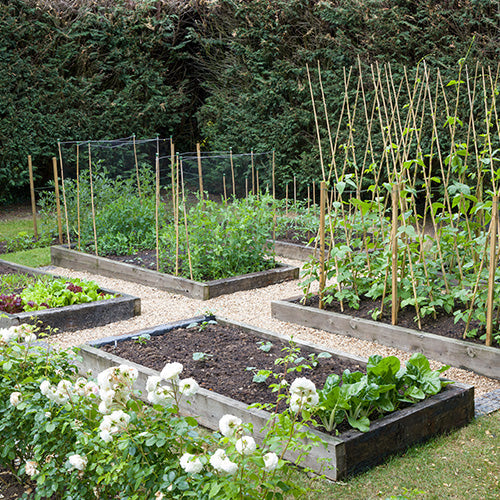How to Grow Rhubarb Crowns
Rhubarb crowns can be planted between autumn and spring, though they should be planted as soon as you receive them. Choose an open site in full sun or where there is no more than very light or partial shade. Don’t plant your crowns in soil that is waterlogged or frozen.
Set plants 90cm (3ft) apart each way and with the growing point 2.5cm (1in) below the soil surface. After refilling with moist soil, firm in each plant with your boot.
Do not pull any sticks in the first season, and pull only lightly in the second year to allow plants to establish and build up strong crowns.
Rhubarb will need very little maintenance while growing as a very easy fruit plant to manage. It’s capable of being productive in your garden for over 10 years when grown in fertile soil, making it a highly worthwhile choice to grow.
How to Force Rhubarb
For an especially sweet and early spring crop, strong plants are easily forced by covering them in January with suitable containers, such as buckets, bins or large pots. Cover these, in turn, with a thick layer of straw and check regularly as they will grow very quickly. The stalks will then be ready for harvesting around eight weeks later. Forcing has a weakening effect on crowns, so don’t force the same plants again for at least two years.
How to Grow Rhubarb in a Pot
As well as growing rhubarb crowns in the ground, rhubarb is also sold as plants for growing in containers. These can be planted and grown all year round, as long as the weather isn’t especially hot and dry. However, it’s best to grow them in spring or autumn.
Choose a container that’s at least 50cm (20in) in diameter and height and grown in quality, peat-free compost. Potted plants dry out faster than plants grown in the ground. So, be sure to bear in mind that your rhubarb plants will need to be grown in evenly moist soil and will need watering in particularly hot weather. Otherwise, the advice found in the rest of this guide will apply.

 How to Grow Rhubarb
How to Grow Rhubarb

 Should You Grow Rhubarb from Seed?
Should You Grow Rhubarb from Seed?

 Ground Prep
Ground Prep

 How to Plant Rhubarb Plants
How to Plant Rhubarb Plants

 Plant Care
Plant Care

 Harvesting
Harvesting

 Problems
Problems

How to Grow
Ground Preparation
Sowing
Planting
Plant Care
Harvesting
Problems




























Leave a comment
All comments are moderated before being published.
This site is protected by hCaptcha and the hCaptcha Privacy Policy and Terms of Service apply.